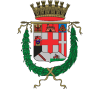The city gateway takes its name from the Ponte Pontecorvo, a three-arched Roman bridge dating from 120-130 A.D. which – though subsequently widened – has maintained its original structure of broad-vaulted arches. It was the accentuated curve of the bridge which gave it its name: Pons Curvus; the arch was necessary to stop the structure being overflowed by the waters of the canal below. Subsequently, the name was commonly distorted to Ponte Corbo and then Pontecorvo.
The best preserved of Padua’s ancient city gateways, Porta Pontecorvo was also known as Porta Liviana, in honour of Bartolomeo d’Alviano (who designed the nearby city walls) and Porta Legnaro or Porta Piove, because it opened onto the road that led to these two important centres to the south of Padua. It was here, according to legend, that St. Giustina was arrested prior to her martyrdom in Prato della Valle. It is said that Roman legionaries stopped her as she was entering the city and, having recognised her as a Christian, demanded that she abjure her faith. St. Giustina’s sole response was to kneel in prayer, the paving slabs softening to cushion her knees; the indentations left would, tradition claimed, remain impressed in the stone.
There is an aedicula here which commemorates this event. From Piazza Pontecrovo you can enter the Treves Gardens, a fine example of an “English Garden” within the city. It was designed by the architect Giuseppe Jappelli for the Treves de’ Bonfili family.
- DISCOVER
- LIVE
FOCUS
- GET INSPIRED
FOCUS
- INFO
- BOOK NOW












